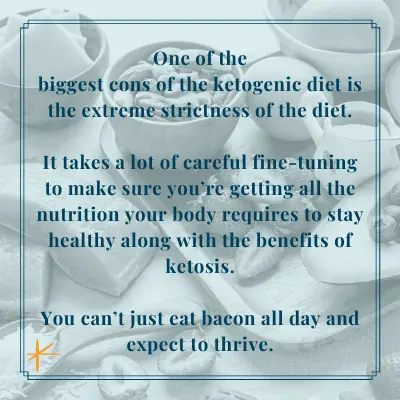Fasting and the ketogenic diet are two of the most popular health and weight loss trends of the past decade. There are pros and cons to each, ultimately dependent on which suits your personal, unique lifestyle better.
In this article, I’ll break down the benefits of each, how the two are similar and where they’re quite different, and a few ways to tell which style of eating is going to be most successful in your life.
Intermittent Fasting vs Keto
Both intermittent fasting and the ketogenic diet put your body into ketosis. Ketosis is a metabolic state where your body is running on fat rather than carbs for fuel.
With intermittent fasting, you restrict all calorie intake, which encourages your system to dip into your fat stores as an energy source, since no new energy is being offered.
In the Ketogenic diet, your restricting carbs only, forcing your body to burn fat for fuel. Even though you’re still consuming calories, once your body is in a state of ketosis, it will burn any and all fat it can, whether that is freshly ingested calories or stored energy that has been hanging around your waistline for too long.
Low-Carb vs Keto
There is a difference between a true ketogenic diet and a low-carb diet, though both of them can have potential health and weight loss benefits. To figure out what is healthiest for you as an individual, you need to understand the subtle differences.
The ketogenic diet is specifically designed to deprive your body of carbs to such an extent that it has no other alternative but to turn to fats to burn as fuel. This means eating fewer than 50 grams of carbs per day, or between 5% – 10% of your daily calorie consumption. 60% – 80% of your calories should come from high quality, healthy fats, and the remainder from high-quality protein.
A low-carb diet, on the other hand, doesn’t restrict carbs enough to put you into a continued state of ketosis. To qualify as low-carb, your daily diet will usually consist of up to 150g of carbs per day and are often high-protein as compared to high fat. Some popular examples of low-carb diets are the Atkins diet or the Paleo diet.
If you don’t have any specific health goals that you’re trying to achieve, such as weight loss or improved insulin sensitivity, low-carb might be an easier diet to follow long-term because it’s slightly more relaxed.
Intermittent Fasting vs Low Carb
Intermittent fasting doesn’t restrict what you eat at all, but merely when you eat. This allows you to get the full benefits of the nutrition and enjoyment of all food groups, and still enter into ketosis occasionally for the health and weight loss benefits.
Following a low-carb diet will likely mean that you’re eliminating a lot of processed foods from your diet. This will lead to some weight loss but doesn’t have any inherent health benefits like the ketogenic diet, sustained ketosis, or fasting. The health results will depend entirely on the quality of protein and healthy fats you eat.
I strongly recommend paying attention to the quality and nutritional value of your food regardless of what diet you choose to follow.
Negatives of Ketogenic Diet
One of the biggest cons of the ketogenic diet is the extreme strictness of the diet. It takes a lot of careful fine-tuning to make sure you’re getting all the nutrition your body requires to stay healthy along with the benefits of ketosis. You can’t just eat bacon all day and expect to thrive.
Micro-nutrition, particularly fiber and antioxidants that are richly supplied in colorful plant foods are mandatory for health. You can find ways to work these into your diet with minimal carbs, but you may also want to look into supplementation, especially if you’re new to the diet and not quite sure of your intake yet.

Low Carb Healthy Fat Diet
A low-carb diet that eliminates processed, empty-calorie carbohydrates will go a long way to improving your health and weight loss goals. Eliminating highly processed foods should be a goal in any diet you choose to follow.
It’s easier to follow for most people than a strict keto diet and it’s not as severe of an adaptation period.
If you’re restricting one major macronutrient, like carbs, you do need to make sure you’re increasing other macros to meet your caloric intake. Adding healthy fats to your diet gets the most energy out of the food you consume. 1 gram of carbohydrates has 4 calories of energy. 1 gram of fat provides you with 9 calories of energy. If you think about food as energy, that is a more efficient conversion.
If you think about food as a pleasure activity in which you’re trying to consume the most calories you possibly can, the most important part of any diet for you will be the mindset shift.



